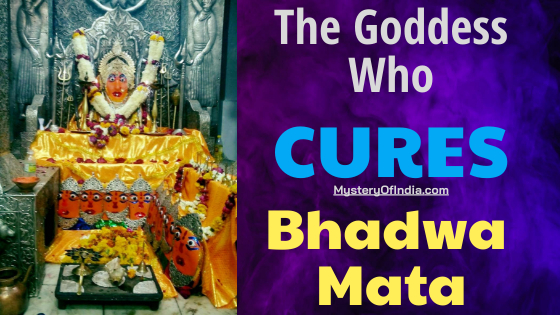Bhadwa Mata- the Goddess who cures
During the night, Mother Goddess Shakti, who is praised and worshipped at the Bhadwa Mata Temple near Neemuch, looms around the hill, and it also looks lovely from the look of it. Everyone was mesmerized out of her sanctum sanctorum, the faith in goddesses. She goes for a walk around the temple. If her gaze falls on a devotee, the devotee will be healed of all ailments. Bhadwa Mata Temple is located in Bhadwa Village, Madhya Pradesh, about 18 kilometers east of Neemuch. Another destination for visitors is a holy site well-known throughout the state. For the locals, this temple holds great religious significance. You may encounter large crowds on weekends or religious holidays, so plan your journey accordingly. To go to the temple, you must travel 19 kilometers from town. Locals strongly believe in Bhadwa Mata, believing that bathing in a well near the temple can cure them of paralysis and Polio. The main celebration of this temple is Navaratri when priests dress Mata Idol in magnificent clothing and jewels.
Bhadwa Mata Temple History
The temple’s beginnings are unknown in antiquity. The shrine was built in its current shape during the 10th and 11th centuries AD, during the reign of the Parmar monarchs. Additions and deletions were made during the 7th, 14th, and 15th centuries. The shrine fell under the authority of Gwalior emperors in the 17th century. Bhils have been doing puja here since the 7th century. During the 15th century, the current murti of the Goddess adored in the temple was placed. The current temple tower was built in portions throughout the 14th century.
Story of Bhadwa Mata Temple
The original murti of Bhadwa Mata venerated in the temple is Ashtabhuja Mahasaraswati — Goddess Saraswati with eight arms. Later, this figure experienced a transformation, and she is now known as Goddess Bhagavati. The Mother Goddess has come here to heal her worshippers of different ailments. Mother Goddess Shakti, in this form, is kind and compassionate. The temple pond is related to the temple’s tale here. Mother Goddess has arrived here, together with the pond, to aid worshippers suffering from different incurable diseases such as smallpox and leprosy.
Bhadwa Mata Murti
The Bhadwa Mata murti is swayambhu, which means it appeared spontaneously. A gigantic crown adorns her head. The murti’s large eyes are its most noticeable feature. Murtis of nine Mother Goddesses, Brahmi, Maheshwari, Kaumari, Vaishnavi, Varahi, Narsimhi, Indrani, Shivdatti, and Chamunda, may be found in the sanctum sanctorum, at the base of the main murti of Bhadwa Mata. Ganesha, Shiva-Parvati, and Vishnu are the temple’s secondary deities venerated under the Sheshnag canopy.
Miracle Pond – Bhadwa Mata Mandir Baawdi
Bhadwa Mata Mandir ki Baawdi is a miraculous pond in the temple complex. The water from the pond, according to common belief, heals a variety of ailments, particularly skin disorders. Thousands of followers have reported that taking a dip in the pond’s water has entirely healed their illnesses. The temple is also known as Arogya Teerth because of its miraculous pond. The holy pond is positioned on the temple’s left side. Devotees use water to take spiritual baths. The most crucial day in the temple is Sunday. Pilgrims come from Madhya Pradesh, Chhattisgarh, Gujarat, Maharashtra, and Rajasthan to visit the shrine. The temple celebrates the Chaitra Navratri (March – April) and Ashwin Navratri (September – October) festivals. During these times, a nine-day fair is held.
Significance of Bhadwa Mata
Brahmi, Maheswari, Kaumari, Vaishnavi, Varahi, Narsinhi, Laundry, Shivdatti, and Chamunda are the nine Nabhdurga idols that surround the Bhadwamata statue. The Bhadwa Mata Temple is one of India’s most significant Shakti temples. Bhadwa Mata Temple worshippers receive ultimate peace of mind and spiritual strength after visiting this temple. Aarogya Theerth is the name given to the holy water Baawdi located within the temple grounds. This holy water is well-known since bathing in it is said to be a magical cure for a variety of skin ailments. This temple has a lot of religious value. Thus it gets a lot of visitors on weekends and religious festivals. Locals strongly believe in Bhadva Mata, believing that bathing in the temple’s well may heal paralyzing diseases like Polio. The main celebration of this temple is Navaratri, during which priests dress Mata Idol in gorgeous clothing and jewels.
Conclusion
Like the origins of most heavenly figures, Kali’s beginnings are believed to originate with tribal tradition firmly anchored in human history. The Atharva Veda, a compilation of hymns and mantras produced between 1200 and 1000 BCE, is where Kl first occurs. She is, however, not a deity but a ferocious black tongue, one of seven belonging to Agni, the god of fire. Kali does not debut as a person for another 450 years when the deity appears in the Devimahatmya approximately 650 CE as a warrior goddess personifying Durga’s anger. Her image at the moment is dreadful: a skeleton and terrifying crone dressed in animal hides and wielding a khatvanga, a skull-topped rod associated with tribal shamans.



